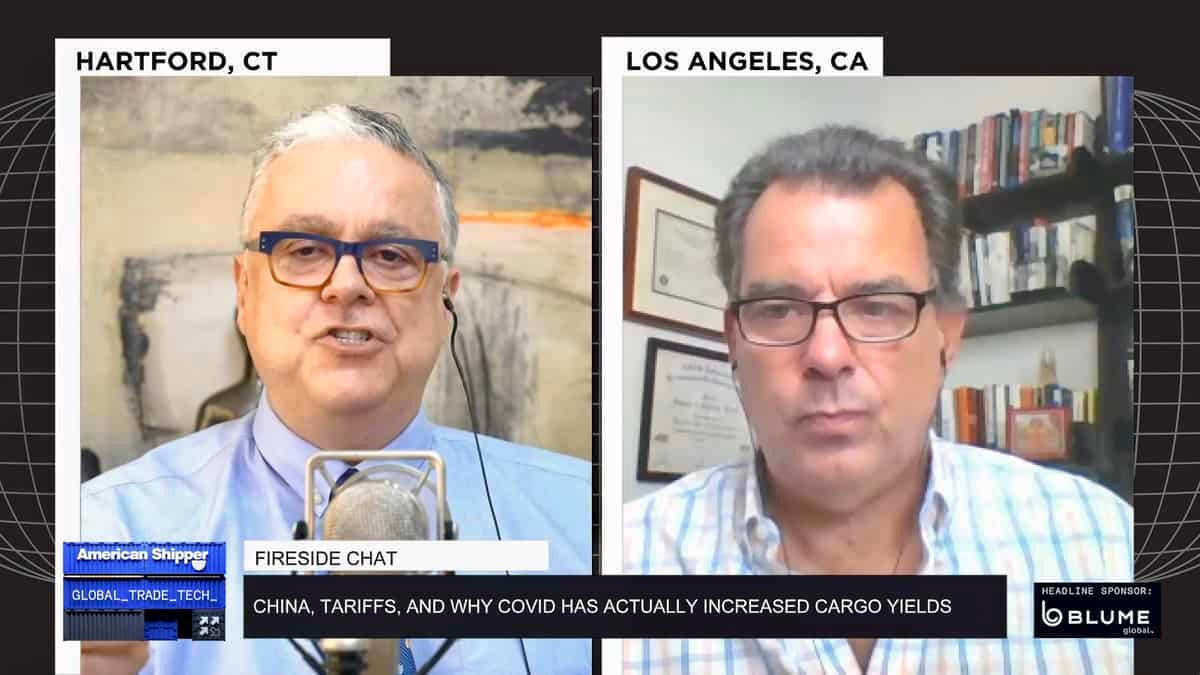With bookings of U.S. imports from China currently up 89% year-over-year (y/y), ocean freight out of China is surging during the COVID-19 pandemic.
Steve Ferreira, CEO of Ocean Audit Inc., and Daniel Gardner, president of Trade Facilitators, recently discussed what’s causing the surge of goods from China and how long it will last.
The virtual fireside chat — “China and tariffs: Why COVID has actually increased cargo yields” — was part of American Shipper’s Global Trade Tech Summit on Thursday.
“I like to look at the velocity of shipments moving out of China. Right now, we have higher rates, and higher spot rates, and the ocean environment is just crunching it right now. So there’s profits being made, you know, out the wazoo,” Ferreira said.
Ferreira noted that from January to August 2019, there were 39 million invoices from China. From January through August 2020, there were 42 million invoices moved from China.
Asia-U.S. West Coast spot rates recently climbed past $3,700 per forty-foot equivalent unit (FEU) in mid-September.
“How might you project three or four months out in terms of where the volatility of the supply chain might be heading, and what could clients do to mitigate that?” Ferreira asked.
Garder said the spike in volume from China is being caused by several factors, including increased shipments of personal protective equipment (PPE), as well as retailers gearing up for the holidays, Black Friday and Cyber Monday.
“We are living in a consumption society where traditional retailers, e-tailers, are placing some pretty big bets on what people are going to buy in the next couple of months,” Gardner said.
Gardner added, “I think it was fairly obvious that that ocean rates were going to go up to the extent that the carriers could manage supply and finally pulled together in the face of an existential threat to their own financial viability and stand their ground on rates.”
According to the FreightWaves Ocean TEU Volume Index, bookings of U.S. imports from China are up 89% y/y through next week, an indication that freight volumes will continue to flow through the rest of September.
During the first week of September, FreightWaves’ Greg Miller reported ocean shipping rates broke records, with 40-foot container rates eclipsing $3,700 in the spot market from China to the U.S. West Coast.
“I think we’re getting to the point now where the rates are, you could use the word abusive, especially given the circumstances,” Gardner said. “As far as the future, I would recommend for people to plan for the long term.”
Gardner said shippers should plan for rates to be high through at least November, and also take a nontraditional approach to contract management.
“Don’t negotiate any rates until a little further into next year,” Gardner said. “Now that gets hard to do, because you run the risk of if you wait too long that there won’t be any space available on ships. But I’d wait a little bit longer, take a nontraditional approach to contract management and contract negotiation going into next year, because I think this big boom is going to be followed by a pretty substantial dip.”
Ferreira said another hot topic is manufacturers discussing leaving China and moving their factories to places like Vietnam or Mexico.
“Gartner did a survey where they said a third of companies had moved out of China or plan to move by 2023,” Ferreira said. “Then the American Chamber of Commerce in China did a survey that said that 84% of [its] members say no movement, we’re going to stick with China. So is a really, really mixed message in terms of where people are moving away.”
Gardner said he has explored for clients the feasibility of moving away from China to countries like Vietnam and Mexico but is uncertain when the market could start to see it reflected in freight volumes.
“I’m a little bit surprised that people haven’t left China sooner because the section 301 tariffs have been around for a couple years now,” Gardner said. “But the question becomes, where are you going to go? Because China has a 40-year head start in terms of production capacity and diversity of products that they make.”
Gardner’s company, Trade Facilitators, has done a lot of work in Latin America; he lived in Mexico for four years.
“Companies that just say, we want to leave China, go to Mexico. Well, that’s a good strategy. But the products you’re looking for, are they even made in Mexico? If they are, where do the raw materials come from, because they’re likely coming from China,” Gardner said. “Mexico, while it is a good, strong market, it does not have the production capacity or the diversity of industries that China has. Nobody does.”
Click for more FreightWaves articles by Noi Mahoney.
More articles by Noi Mahoney
Border trucking capacity remains tight; Schneider Electric expanding in Tijuana
Trump administration to investigate Mexican produce imports
New USMCA trade deal could increase demand for nearshoring in Mexico
Ace Hardware expanding into Mexico
FedEx Logistics expands in El Paso; Stanley Black and Decker picks Mexico for new plant











